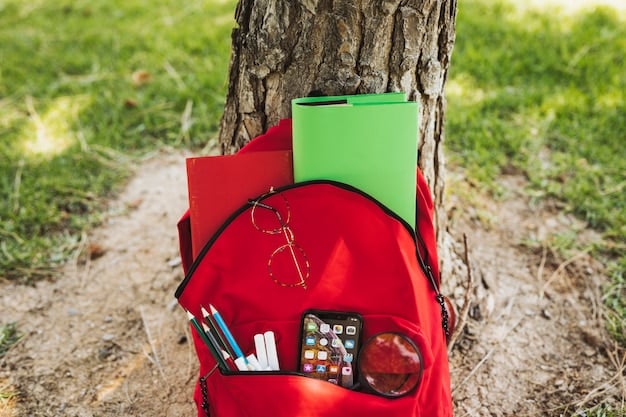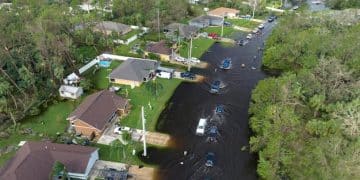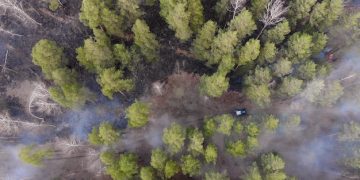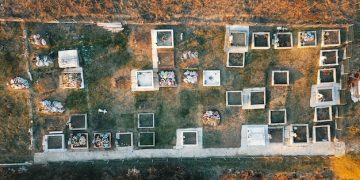72-Hour Extreme Weather Prep Guide: Family Safety First

To prepare your family for a 72-hour extreme weather emergency, systematically assemble an emergency kit, develop a communication plan, secure your home, and practice evacuation routes to ensure safety and resilience during unforeseen events.
In an increasingly unpredictable world, the threat of extreme weather events looms larger than ever. From blizzards to hurricanes, tornadoes to floods, these natural phenomena can strike with little warning, disrupting lives and infrastructure. The key to mitigating their impact isn’t just reacting when they occur, but proactively preparing well in advance. Understanding how to prepare your family for a 72-hour extreme weather emergency is not merely a recommendation; it’s a critical component of modern family safety and resilience. This comprehensive guide outlines the essential steps your family can take to be ready when disaster strikes.
Understanding the 72-Hour Imperative
The concept of the “72-hour kit” or “72-hour preparedness” is a cornerstone of emergency planning. It stems from the understanding that in the immediate aftermath of a widespread disaster, first responders and emergency services may be overwhelmed or unable to reach everyone for up to three days. This critical window means your family must be self-sufficient during this initial period. It’s about more than just food and water; it encompasses shelter, communication, sanitation, and even psychological well-being. This initial self-reliance is vital for survival and allows emergency services to prioritize the most critical situations, knowing that many are already taking care of themselves.
Extreme weather events can manifest in numerous forms, each presenting unique challenges. A hurricane might bring devastating winds and flooding, requiring sturdy shelter and evacuation plans. A blizzard could trap families indoors for days, necessitating warmth, non-perishable food, and alternative power sources. Earthquakes offer no warning, demanding immediate response and structural safety considerations. The universality of the 72-hour preparedness principle lies in its adaptability; while specifics may vary by threat, the core components of self-sufficiency remain constant. It’s about building a foundational resilience that can be tailored to specific regional risks.
Defining Your Regional Risks
Identifying the specific extreme weather events most likely to affect your area is the first step in tailored preparedness. Are you in a hurricane zone, a tornado alley, or prone to blizzards? Understanding these localized threats allows you to refine your 72-hour plan. For instance, a family in Florida would prioritize water purification and hurricane shutters, while a family in Michigan might focus on insulation and alternative heating. Local emergency management agencies offer invaluable resources, including historical data, risk maps, and specific guidance for your region.
- Research local weather patterns and historical disaster data.
- Identify the top 2-3 extreme weather threats in your specific geographic area.
- Consult local emergency services websites for region-specific advice.
Once you’ve assessed your specific risks, you can begin to build your preparedness strategy around them. This doesn’t mean ignoring universal preparedness principles, but rather emphasizing certain aspects. For example, if you live in an area prone to wildfires, having N95 masks and fire-retardant materials might be a higher priority than for someone in a flood plain. This localized approach optimizes your resources and significantly enhances your family’s safety during an emergency. Thorough risk assessment transforms generic advice into actionable, personalized plans.
The purpose of the 72-hour preparedness strategy is not to create a bunker mentality but to empower families with the tools and knowledge to navigate the initial, most chaotic phase of a disaster. Having a well-thought-out plan reduces panic, enhances decision-making, and contributes to the overall resilience of the community. It’s about taking responsibility for your own immediate safety, thereby freeing up crucial resources for those who are most vulnerable or severely impacted.
Assembling Your Emergency Kit: The Essentials
Your 72-hour emergency kit, often called a “go-bag” or “bug-out bag,” is your family’s lifeline. It should contain everything needed to sustain life and maintain basic comfort for three days, regardless of whether you shelter in place or evacuate. This kit should be easily accessible and portable, ideally with individual bags for each family member, tailored to their specific needs. Think about what you would absolutely need if you had to leave your home with only minutes’ notice or if power and water were suddenly unavailable.
Start with the fundamental human needs: water, food, and shelter. Water is perhaps the most critical. Aim for at least one gallon of water per person per day for drinking and sanitation. Non-perishable food items that require no cooking or refrigeration are ideal. Beyond these, consider first aid, hygiene, communication, and warmth. A comprehensive kit considers both physical survival and mental well-being, providing a sense of security during a chaotic time.
Water and Food Supplies
The importance of clean drinking water cannot be overstated. Store bottled water in a cool, dark place, and rotate it every six months. Consider water purification tablets or a portable filter as backups. For food, pack high-calorie, non-perishable items like energy bars, dried fruit, nuts, and canned goods. Don’t forget a manual can opener if you include canned items. Think about dietary restrictions and preferences for each family member, especially children.
- Minimum 1 gallon of water per person per day.
- Non-perishable food, easy to prepare (e.g., ready-to-eat meals, protein bars).
- Water purification tablets or life straw for backup.
Rotate your food and water supplies periodically to ensure freshness and effectiveness. A good practice is to tie this to a regular event, such as daylight saving time changes, when you adjust your clocks. This simple habit ensures your emergency supplies are always ready for immediate use. Also, consider the specific caloric needs of family members, especially those with high energy requirements or specific medical conditions during a stressful period.
First Aid and Medications
A well-stocked first aid kit is non-negotiable. It should include bandages, antiseptic wipes, pain relievers, and any prescription medications your family members need. Keep a detailed list of all family prescriptions, including dosages and doctor contact information. Consider adding over-the-counter remedies for common ailments like allergies or stomach upset. Regular review of expiration dates for medications is essential to ensure they remain effective when needed.

Beyond traditional first aid, think about specialized medical needs. Are there any family members with chronic conditions like diabetes or asthma? Ensure you have at least a 72-hour supply of their specific medications, clearly labeled and easily accessible. A comprehensive medical preparedness strategy can alleviate significant stress during an emergency, allowing you to focus on other immediate concerns. Regularly check expiration dates on all medical supplies.
Sanitation and Hygiene
Maintaining hygiene is crucial during an emergency to prevent the spread of disease. Pack hand sanitizer, wet wipes, garbage bags (for waste disposal), and personal hygiene items like soap, toothpaste, and feminine products. If plumbing is compromised, a portable toilet or bucket with trash bags can be invaluable. These items, though often overlooked, contribute significantly to comfort and health in a challenging environment.
Even simple items like toilet paper and paper towels can make a big difference in maintaining normalcy and sanitation. Consider also pet hygiene supplies if you have animals, as their needs must also be factored into any comprehensive family plan. A clean environment, even in crisis, can prevent secondary health issues and maintain morale.
Developing a Family Emergency Plan
An emergency kit is only half the battle; knowing how to use it and having a clear action plan is equally vital. A family emergency plan outlines what to do, where to go, and how to communicate during a disaster. This plan should be discussed and practiced regularly, ensuring every family member understands their role and responsibilities. Disasters are chaotic, but a well-rehearsed plan injects a crucial element of order into the confusion.
Start by identifying multiple meeting points, both near your home and outside your neighborhood, in case you can’t return home or are separated. Designate an out-of-state contact person who all family members can call to check in, as local phone lines may be overwhelmed. These fundamental steps create a communication network that can bridge distances and ensure accountability during a crisis. The goal is to minimize uncertainty and maximize the chances of reunification.
Communication Strategy
In a disaster, traditional communication methods like cell towers and landlines can be compromised. Discuss alternative communication methods: text messages often get through when calls don’t, and social media can be used to check in safely. Consider a battery-powered or hand-crank radio for official emergency broadcasts. A communication tree or chain can ensure family members and close friends are updated.
- Establish an out-of-state family contact.
- Practice sending text messages as primary communication.
- Identify a family meeting point outside the immediate neighborhood.
Print a hard copy of important contact numbers, including emergency services, doctors, and family members, as cell phones may run out of battery or networks may fail. This low-tech solution can be a lifesaver when digital options are unavailable. Teach children how to dial 911 and memorize key phone numbers. Every family member, even young children, should have a basic understanding of this communication plan.
Evacuation Routes and Shelters
Knowing when and how to evacuate is critical. Identify at least two evacuation routes from your home and neighborhood, considering different types of disasters (e.g., flood vs. wildfire). Research local public shelters or designate a friend or relative’s home as a safe meeting point outside your immediate area. Practice these routes during non-emergency times to familiarize everyone. The adage “fail to plan, plan to fail” holds true here; familiarity breeds confidence, and confidence saves lives.
Evacuation orders should always be taken seriously. Have a pre-packed grab-and-go bag for each family member for quick departure. Include important documents (copies, not originals, if possible), such as identification, insurance policies, and birth certificates. These documents are difficult to replace and crucial for recovery efforts after a disaster. A checklist for evacuation can ensure nothing critical is left behind in the rush.
Securing Your Home and Property
While the 72-hour kit focuses on personal needs, preparing your home for extreme weather can significantly reduce damage and increase safety if you shelter in place. This involves a combination of structural reinforcement, utility management, and general hazard mitigation. Proactive measures taken now can save thousands in repairs and prevent injuries later. It’s about building resilience from the outside in, protecting your most valuable asset: your home.
Consider the specific threats your home faces. For hurricanes, securing loose outdoor items and reinforcing windows is paramount. For blizzards, preventing frozen pipes and ensuring adequate insulation are key. Regular maintenance, such as cleaning gutters and trimming trees, can also play a significant role in preventing secondary damage during a storm. A secure home provides a vital sense of safety and shelter during an extreme event, especially if evacuation is not possible.
Utility Shut-Offs
Knowing how to shut off utilities (electricity, water, gas) is vital in an emergency. Damaged lines can pose severe hazards like electrocution, flooding, or explosions. Locate your main shut-off valves and breakers, and ensure all adult family members know how to operate them. Attach a wrench or tool to the gas shut-off valve for quick access. Practicing these actions can prevent further damage to property and minimize risks to personal safety.
Clearly label all shut-off points to avoid confusion during a stressful situation. It’s also wise to check local regulations regarding gas shut-off; some areas require a professional to turn gas back on after it’s been shut off. Understanding these nuances is part of comprehensive home preparedness. The ability to quickly and safely control utilities can be the difference between minor inconvenience and catastrophic damage.
Home Reinforcement and Hazard Mitigation
Depending on your regional risks, consider reinforcing vulnerable areas of your home. This might include installing hurricane shutters, strengthening garage doors, or sealing cracks in your foundation to prevent water intrusion. Secure tall, heavy furniture to walls to prevent tipping during an earthquake. Clear eaves and gutters of debris to ensure proper drainage during heavy rains. These seemingly small actions collectively contribute to a more resilient home.

Regular tree maintenance is also critical, especially for trees near your home, as falling branches can cause significant damage during high winds or heavy snow. Store valuable documents in waterproof containers or off-site in the cloud. Review your home insurance policy to understand your coverage for different types of disasters. Proactive home maintenance and preparation are investments that pay dividends in peace of mind and protection.
Special Considerations for Families
Every family is unique, and emergency preparedness must reflect those specific needs. Children, seniors, individuals with disabilities, and pets all require tailored considerations in your 72-hour plan. Generic advice often falls short, so personalizing your strategy ensures that every member of your household is accounted for and adequately protected. This empathetic approach to preparedness acknowledges the diverse needs within a family unit.
For children, involve them in the planning process in an age-appropriate manner to reduce anxiety and build their understanding. For seniors, ensure accessibility and consider their specific medical or mobility needs. Individuals with disabilities may require specialized equipment or assistance during evacuation. Pets are family too, and their food, water, and shelter needs must be factored into the overall plan. Comprehensive family preparedness accounts for everyone, leaving no one behind.
Children and Seniors
When planning for children, involve them in age-appropriate discussions about safety. Explain what to do in terms they can understand, reducing fear and empowering them with knowledge. Pack comfort items like a favorite toy or book in their individual go-bags. For seniors, ensure their emergency kit is tailored to their specific needs, including extra medications, assistive devices (e.g., glasses, hearing aids), and easy-to-open food. Consider their mobility limitations when planning evacuation routes and meeting points.
- Involve children in the planning; pack comfort items for them.
- Tailor senior kits with extra medication and easy-access items.
- Ensure all family members know how to contact each other and the out-of-state contact.
For both groups, clear, concise instructions and repetitive practice are key. Visual aids or simplified checklists can be helpful. Designate a specific adult responsible for assisting children or seniors during an emergency. The goal is to provide a sense of security and clarity during a potentially frightening event, minimizing confusion and maximizing safety for the most vulnerable family members.
Individuals with Disabilities and Pets
Individuals with disabilities may require specialized considerations. This could include power sources for medical equipment, specific dietary needs, or communication aids. Coordinate with caregivers or support networks to ensure they are aware of and integrated into your emergency plan. Evacuation routes may need to be assessed for accessibility, and transportation options secured in advance. Every detail matters when ensuring the safety of those with unique needs.
Pets are often overlooked in emergency planning, yet they are part of the family. Prepare a separate pet emergency kit with food, water, medications, bowls, and a carrier. Have recent photos of your pets for identification. Identify pet-friendly shelters or make arrangements with friends or relatives outside your area. Never leave pets behind during an evacuation; plan for their safety as meticulously as you do for human family members. Their well-being contributes to the overall stability and morale of the family during a crisis.
Practice and Maintenance for Ongoing Readiness
Building an emergency kit and creating a plan are excellent first steps, but true readiness comes from regular practice and consistent maintenance. Emergency preparedness is not a one-time task; it’s an ongoing process. Just as fire drills are practiced in schools, family emergency drills should be conducted at home. This reinforces procedures, identifies weaknesses in your plan, and builds muscle memory for quick, decisive action when it matters most.
The world is dynamic, and so should your emergency plan be. Family members grow, needs change, and the climate continues to evolve, bringing new threats. Regularly updating your kit and reviewing your plan ensures they remain relevant and effective. This commitment to continuous improvement distinguishes true preparedness from a mere static collection of supplies. It cultivates a resilient mindset within the family.
Regular Drills and Refreshers
Conduct family emergency drills at least once a year. Practice evacuating your home, walking your designated routes, and meeting at your safe locations. Rehearse communication protocols, including using your out-of-state contact. Make it a fun, collaborative activity, especially for children, to desensitize them to the serious nature of the drills. After each drill, debrief to identify areas for improvement and celebrate successes.
These drills do more than just refine the plan; they build confidence and reduce panic during an actual emergency. The psychological benefit of knowing what to do, even under extreme stress, is immense. Consistent practice makes the emergency plan second nature, allowing your family to react efficiently and effectively when a real crisis unfolds. Consider practicing different scenarios, like power outages or sheltering in place during a storm.
Kit and Plan Updates
Your emergency kit and plan are living documents that need periodic review and updates. Check expiration dates on food, water, and medications every six months. Replace batteries in flashlights and radios annually. Update contact information, particularly for the out-of-state contact. As children grow, their clothing and shoe sizes in the kit will need adjustment. Consider seasonal changes: for example, add warm blankets in winter and lighter items in summer if your kit is stored.
Review the entire family emergency plan annually, preferably around a significant date like the New Year or a birthday. Discuss any changes with all family members, especially if new members join the household or circumstances change. This continuous cycle of review, update, and practice ensures your family remains prepared for whatever extreme weather events may come your way. This diligent maintenance is the final piece of the preparedness puzzle.
| Key Preparedness Point | Brief Description |
|---|---|
| 💧 Emergency Kit Essentials | Stock 72 hours of water, non-perishable food, first aid, and hygiene supplies. |
| 📞 Family Communication Plan | Designate an out-of-state contact and multiple meeting points. |
| 🏡 Home & Property Security | Know utility shut-offs and reinforce your home against specific threats. |
| 🔄 Practice & Maintain | Conduct regular drills and update kits and plans periodically. |
Frequently Asked Questions
▼
A 72-hour extreme weather emergency refers to a period where a significant weather event (e.g., hurricane, blizzard, tornado aftermath) disrupts essential services like power, water, and access to emergency responders for up to three days. It emphasizes self-sufficiency during the immediate recovery phase.
▼
It’s recommended to review and update your family’s emergency kit and plan at least twice a year, ideally every six months. This ensures food and water haven’t expired, medications are current, and clothing sizes are appropriate, adapting to changing family needs and potential new risks.
▼
Common mistakes include procrastinating on preparation, failing to customize kits for individual family needs (especially children, seniors, or pets), not practicing emergency drills, and neglecting to establish an out-of-state communication contact. Overlooking home reinforcement is also a frequent oversight.
▼
Consider a portable power bank for charging devices, a hand-crank or solar-powered radio, a multi-tool, a portable water filter, a small tent or tarp for temporary shelter, and robust work gloves. Specialized rescue tools may also be beneficial for certain scenarios specific to your region.
▼
Educate children through age-appropriate discussions, engaging them in assembling their own small kit, and turning drills into fun games or role-playing scenarios. Focus on empowerment and problem-solving, emphasizing that preparedness helps keep everyone safe and calm, rather than instilling fear.
Conclusion
Preparing your family for a 72-hour extreme weather emergency is an investment in safety, peace of mind, and resilience. While the task might seem daunting, breaking it down into actionable steps—from assembling a comprehensive kit to developing a robust communication plan and securing your home—makes it manageable. Regular practice and consistent maintenance transform static preparations into dynamic, effective safeguards. In an unpredictable world, proactive preparedness is not just a recommendation; it’s a fundamental responsibility that empowers families to face challenges with confidence and emerge stronger on the other side.





